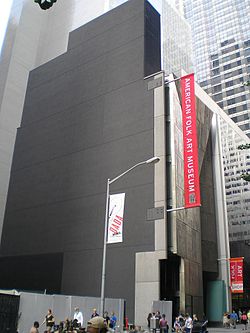Fuse News: NYC’s The American Folk Art Museum — Destroying it as Vandalism.
By Harvey Blume.
It’s notable and heartening when informed critical opinion manages to stop a juggernaut in its tracks. It’s too soon to say for sure, but that seems to be exactly what’s happening on W. 53 St. in Manhattan, where the Museum of Modern Art is suddenly reconsidering its plan to demolish the adjacent American Folk Art Museum because a chorus of prominent writers and critics are denouncing the move.
A bit of history is in order: the Folk Art Museum was long housed in a modest gallery space opposite Lincoln Center. In 2001, the collection expanded into a W. 53 St. structure designed by architects Tod Williams and Billie Tsien (who likewise designed Philadelphia’s new Barnes Museum) that was praised by Michael Kimmelman, the NY Times critic, as “a striking sliver of building.” A bit of personal history might be in order as well: I was often drawn to the W. 53 St. space, whether or not I also visited MoMA next door.
On W. 53 St., the curators could mount shows that were hardly conceivable in a gallery venue. Henry Darger was always represented—the museum owns most if not all of this foundational, if such a word can be used in this context, outsider’s work. Adolf Wölfli and Martin Ramirez, among others, received full treatment during that building’s attenuated existence. It would have been difficult to believe, as I became accustomed to this museum—its encrusted, jagged facade that contrasted not unfavorably to MoMA’s rectangles and right angles—that the building was to be so short-lived a venue for outsider/folk art.
Perhaps the appetite and market for outsider art was hit especially hard by the Great Recession in an art world equivalent of last hired, first fired. If so, that story remains to be told. In any case, in 2011, folk art officials sold the heavily indebted structure to MoMA. There was suspense for a while about where the permanent collection would go and if it would remain intact and some satisfaction in learning the museum would retreat into its original space opposite Lincoln Center without loss of holdings. Then MoMA announced plans not to use, even for purposes of storage, but to demolish the W. 53 St building.
What we are in the midst of now is an enraged and possibly potent reaction from the art world. It began with a piece by noted architecture critic James S. Russell denouncing MoMA’s plans as a “flabbergasting act of cultural vandalism.,” and accusing MoMA, “a museum with a huge endowment” of succumbing to “a troubling sense of empire.”
That was followed by Martin Filler’s full-length critique in the New York Review of Books in which this acclaimed critic wrote that “The idea that Williams and Tsien’s structure has to go because its striking, nearly windowless façade does not blend in with MoMA’s banal 53rd Street elevations is simply preposterous.” The attention in Filler’s piece goes from a defense of the folk art building to an attack on MoMA’s very aesthetic.
Now Michael Kimmelman, the New York Times writer, in what may be a decisive entry into the debate, like Filler, challenges MoMA’s power and purpose. “Midtown and MoMA,” he writes, “could both use more variety, serendipity and soul. The former folk art museum building, having all those things, isn’t an obstacle to progress but an opportunity.”
The upshot is that the juggernaut has paused. The firm of Diller Scofidio & Renfro—familiar to Bostonians from the Institute of Contemporary Art and to New Yorkers from the creation of the High Line and the redesign of Lincoln Center—has been called in by MoMA to assist in a reconsideration. Kimmelman ends his piece by writing that “New Yorkers can make themselves heard when it comes to shaping the public realm” and that “Institutions, lavished with tax breaks, responsible to the people, would do well to listen.”


I had a rent control studio apartment on east 54th street in 1972, cost me hardly anything, had MOMA for a near neighbor although I lived on a less desirable block. Lived there about 6 months.
Near to Third Avenue, my apartment was across the street from a regional post office with trucks roaring all night. Maybe it was 53rd Street.
Much as I liked your strong blog on the MoMA/Folk Art Museum controversy, and flattered as I am to be called “acclaimed,” I should point out that the uproar was not started by Jim Russell, whose Bloomberg post appeared on April 23, but actually by my New York Review blog, which went up on Friday April 12, which was then followed by my longer print version, datelined April 25, in the May 23 edition.
All best,
Martin Filler
While I see no reason to revise my calling Martin Filler an “acclaimed” critic except perhaps, at the risk of redundancy, to add “prominent”, “prolific” and “influential,” I am pleased to learn it was he who ignited opposition to the Modernist bulldozer aimed at the Folk Art Museum building.